TBA:13 in Reviews
We’ve come to the end of another epic Time-Based Art festival—that is, 11 days of gorging ourselves on art (not to mention more than a few dressed up but nonetheless guilty hotdogs at the Carnival Without Rides). How was it? Like all festivals: good and bad.
The Con-Way warehouse that housed the fest HQ, the Works, was excellent, serving up an empty canvas to be outfitted with a black box theater, a bar made of shipping palettes, a tree-lined beer garden, galleries, and plenty of parking(!) (although it did have sound issues and was almost a little too big to feel full at times). The result was palpable: the crowds lingered late and the energy felt much more cohesive than its former multi-year home at the Washington High School—particularly for the Drag Ball, which drew over 1200 people who yelled themselves hoarse and is hopefully the beginning of a new tradition. (Drag Ball as the new Ten Tiny Dances?) Sadly, it was a one off, as the building will be a New Seasons by next year's TBA.
The main stage shows, despite some strong artists, left me wanting more diversity. With 11 out of the 18 shows being dance-based, the festival felt heavily lopsided with a higher bar of accessibility than previous years (if you’re not in the contemporary dance conversation, a number of the shows were rather impenetrable). But that’s one risk we take to have so many world/US premieres—of which this fest was chock full, which should make Portland proud.
Here are my favorites looking back, as well as my least favorite. Below them is a recap of our reviews if you weren’t able to make it or want to compare notes. As for the visual art track, that review is still to come.
Best in Show:
When it comes to top-of-their-game performers, the playing field didn’t even seem fair. International cabaret star Meow Meow is world class, and backed by Pink Martini’s Thomas Lauderdale and the full symphony, to say nothing of the special guests, it took the symphony crowd to places they’d never imagined (e.g. crowd surfing and seeing conductor Carlos Kalmar in his undergarments). Of course, the show was not without flaw. Lauderdale and the symphony kept a downright peppy pace that defanged the darker edges that gives Meow depth, particularly on songs like Amanda Palmer’s “Miss Me” and “Surabaya Johnny,” and the whole thing could’ve benefitted from a little more rehearsal. But the beauty of Meow is the ability to spin the smallest of flaws to the biggest disasters into gold. [A fuller review is below.]
Best New Discovery:
Israeli-born Canadian performer Itai Erdal was the sneak attack of the festival. To my knowledge, he didn’t figure into any of the local media’s preview coverage, and none of the curators I spoke with ahead of time mentioned him. Yet his performance, at least for me, was the most poignant, effecting, thought-provoking, and, I’d argue, courageous of the fest (the man confessed to an act of profound emotional ramifications, not to mention potentially criminal ones). It was like watching a top notch This American Life story performed live, but instead of music pulling at your heart strings, Erdal, a lighting designer by trade, simply used lights. His humorous and clever explanations of how the craft affects a stage performance not only built the emotional heft of his story and set him apart from any other storyteller, but it made me watch every show thereafter differently. (I got so much more out of Bouchra Ouizguen and, especially, Nacera Balaza than I think I would’ve otherwise.) Full review.
Best Cross-Cultural Introduction:
I have to admit, after watching the videos for North African dancers Bouchra Ouizguen and Nacera Balaza when they were first announced, I was nervous that they might leave Portland audiences (not always the most open to cross-cultural works) as frustrated as Nora Chipamuire did last year. And indeed, with their achingly slow lights-up beginnings and repetitious movements, they had that effect on some. Yet there was something ecstatic and even spectral in their rhythms that led us from riveting engagement to boredom to amazement at their stamina to a state of hypnosis and back. (If it hadn’t been for its similarity to Mexico-based theater company Lagartijas Tiradas al Sol last year—albeit much more successful—Lola Arias’s company would be in this spot.)
Review of Ouizguen’s Ha.
Review of Balaza’s Le Trait and Le Temps Scelle.
Thoughts on Dance + the Most Likely to Give Contemporary Art a Bad Name:
As I said, this year’s fest was full of contemporary dance, most of it diving headlong into the deep end of the conceptual and consequently leaving large parts of its audience behind. The visiting artists presented a bit of a spectrum on, let’s call it, the accessibility/challenge scale. Campo was trousers down my favorite, pushing the boundaries of anything I’ve seen—and of physical interaction itself—but still managing to bring the audience along. Miguel Gutierrez’s premiere had exceptional production values (it’s lighting and sound design was sublime), but it’s performance didn’t measure up—or perhaps overmeasured: the last 30 minutes were wonderful, if only they’d cut the first 60 in half. Trajal Harrell’s work willfully alienated its audience and was far more interesting to those with knowledge of dance history, but the sheer pleasure of its vogueing element saved it for the less knowledgeable. And Karen Sherman was more laborious than charming.
While I struggled with each, the work I had the most difficulty with was Laura Arrington’s and Jesse Hewit’s Adults. The performance started out with incredible potential: with the audience in a corner of the Works facing the entire warehouse, the first 10 or so minutes seemed like Arrington and Hewit would make full, incredible use of a space that was dying for it. But then they threw the space out, proceeding to perform next to no movement in light far to dim for anyone but the front row to see (highlighting how a space affects a work, I craved seeing Nora Chipamuire’s work from last year in Con-Way, where I think it would’ve been so much more successful). The second half saw the duo howling, spinning, and generally traipsing about in a series of costumes, barely interacting. Besides the tension between childhood/adulthood and a few beautiful moments, the work felt self-indulgent, sloppy, and impenetrable for the sake of being impenetrable.
I like work that challenges, and I believe that artists should be following their urge to create. But far more than the other experimental dance works in the fest, this piece felt like a jargon-fueled academic paper that mistakes intentionally dense language for deep meaning. It’s not enough for the artist to have a vision. They have to communicate it. Otherwise, you're doing your artform a disservice. (My hunch is this took the cake for folks walking out, some of whom might not come back).
TBA:13 in Reviews
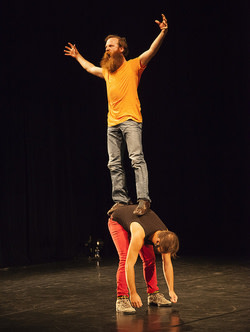
Image: Gia Goodrich
Day 2 - CAMPO/Pieter Ampe & Guilherme Garrido: Still Standing You
If you ever were a boy, had boys, played with boys, or wanted to be one, you’ll recognize the romp of punishment and play taken to the extreme that was Pieter Ampe and Guilherme Garrido’s Still Standing You. These two friends demolished every physical boundary of their relationship in a dance of humor, intimacy, sadism, and tenderness. You haven’t laughed until you’ve seen a grown many bellow into the foreskin of another like it’s a blow horn.
Day 2 - Trajal Harrell: Judson Church is Ringing in Harlem (Made-to-Measure)
The beginning of this conceptual fantasy exploring the meeting of Judson Church’s post-modern dance scene with Harlem’s vogueing ball scene was long and uncomfortable. Spotlights shined in the audience’s eyes, Adele’s “Set Fire to the Rain” blared out of the speakers, and the three dancers sat in chairs and did next to nothing. But then, halfway through, the dam broke, and the vogueing rushed forth in a deluge. An audience close to nodding off minutes before was suddenly bouncing in its seats. In other words, M2M didn’t make for an easy journey, but ultimately getting to watch them learn to werk it was worth the struggle.
Harrell’s second performance, Antigone Jr., was blissfully shorter yet even more impenetrable in its concept.
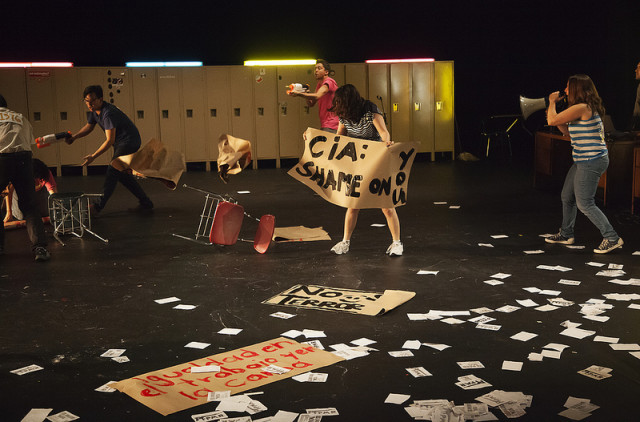
Image: Gia Goodrich
Day 2 - Lola Arias: El año en que nací
This multimedia retelling of the Pinochet dictatorship through the Chilean performer's parents' lives was an evocative and touching convergence of personal and national history, and a crucial reminder of how hard the two are to pull apart. Though the show’s unorthodox and sometimes clunky presentation didn’t always perfectly hit the target, when it did, it left a mark.
Day 2 - bobbevy: This is how we disappear
The Portland company contemplated time and relationships through contemporary dance and custom electronics, including videos of flying birds and row after row of identical trees, as well as an interlude of rapidly cycling fluorescent animal images projected over the dancers’ faces. With less skillful execution, the digital elements would have been distracting at best. But somehow, despite the electronically wired costumes and synthesized backdrop, this meditation on time and relationships was, at its core, simply a beautiful dance.
Day 2 Works- Peter Burr: Special Effect
Green lasers. Smoke machines. A big screen and a stage strewn with electronic gadgets, baubles, and shells. Like some electronic shaman, Burr took us on a multimedia vision quest.
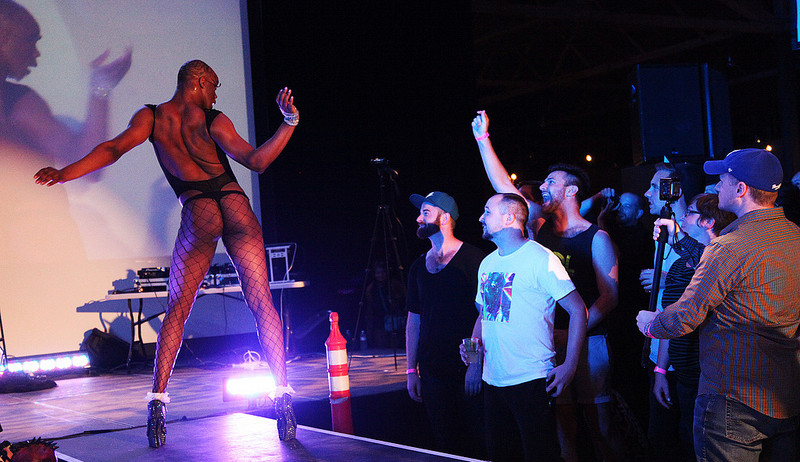
Image: Gia Goodrich
Day 3 Works - Critical Mascara: A Post-Realness Drag Ball
Portland turned it out for a runway battle of fierceness and glamour. Categoris: Diva Practice, Glamour Gore, Vogue, and Haaaaiiiirrrr. Audience: insane. Here were there looks. Check out the slide show here.
Day 3 - Meow Meow and Thomas Lauderdale with the Oregon Symphony
So I haven't had the chance to review this show, which is kind of stupid, because it was far and away the best performance I've seen yet at the festival—and the most sheer unadultated pleasure I've had at a show in a long time.
Meow Meow is a cabaret diva of the first order, and she put on a performance unlike anything you've ever seen with a symphony and likely ever will see again. She started the show in the balcony and proceeded to cover almost every foot of the Schnitz (and a half dozen languages) in her explosive kamikaze performance that took more than a few symphony regulars by surprise. She stage dived (some older patrons huddled in their seats, arms overhead, trying to shield themselves as the vamp passed over). She pulled audience onstage to be her chair and mic stand. She ended up in a slip at the start of the second act (turns out her gown had only been rented for the opening number) and forced Carlos Kalmar and Thomas to strip to their undies, which were revealed to be union jack suits. She was joined first by the Von Trapp children to yodel through "The Lonely Goatheard," and then by the Portland Youth Philharmonic and the Portland Gay Men's Choir for a grand finale worthy of the The Muppet Show. She got three standing ovations (one at intermission!) And then she broke our hearts with the encore, a cover of Patty Griffin's "Be Careful" in almost total darkness. It was the most beautiful disaster.
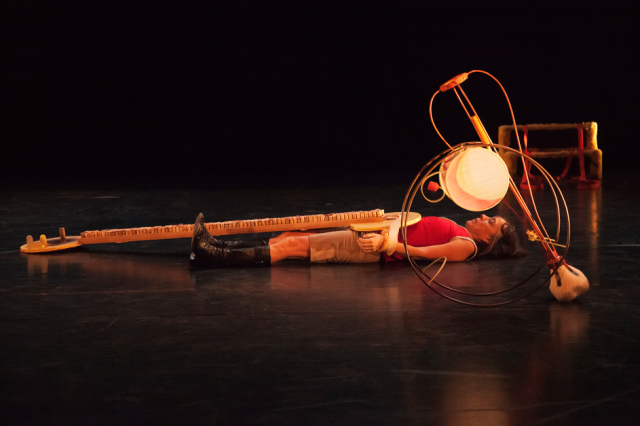
Image: Gia Goodrich
Day 4 - Linda Austin and David Eckard: Three Trick Pony
Of the many challenges a dancer/choreographer can take on, 60 minutes on stage solo is about as hard as it gets. Second hardest would be dancing with props. For Three Trick Pony, longtime Portland dance-maker Linda Austin combined the two. She also added a third risk, using sculpture for the props, in this case, by longtime local sculptor David Eckard. There were moments of high craft, concept, and, once in a while, humor. Yet, unfortunately, this was a dance longer on transitions than fusion.
Day 4: the Blow
We didn't review the New York-via-Portland art-pop duo's show, but we did talk with them before the fest about pop music, their long-awaited new album, and Lady Gaga.
Day 4 Works - Nick Hallett: Rainbow Passage
The New York composer brought a scientific text to saturated sonic life with help from singers including Holcombe Waller, the Julians, Matt Carlson, and Jonathan Sielaff.
Day 4 Works - Like a Villian: Make Well
Musician Holland Andrews declared early in her one-woman show that her goal was to leave her audience feeling spiritually healed. It’s a bold claim that might feel a little ambitious until the first notes from Andrews’ solo project reveal a singer who—and I’m trying not to be hyperbolic here—basically redefines what it means to be in complete command of one’s voice.
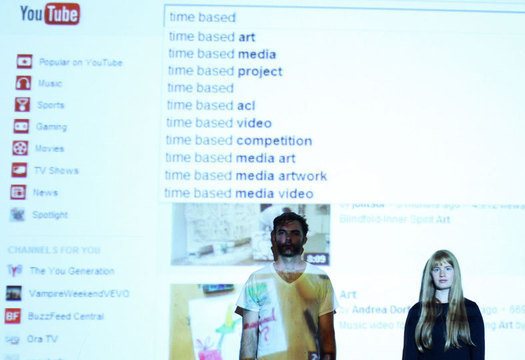
Day 5 Works - Getting To Know You(Tube)
A team of “experts” led us deep into the culture of YouTube—a journey both hilarious and profound (but mostly hilarious). From an exploration of the cover song (and the covers of covers) with Taio Cruz’s “Dynamite” as our subject to rare gems like Chewbacca dancing to Guns and Roses “Welcome to the Jungle” to the most infamous part: the comments section.
Day 6 - Third Angle New Music: In the Dark
The new music ensemble’s solved the age-old problem—what do you look at during a concert—by plunging you into complete and utter blackness at the OMSI Planetarium (unless you’re a regular caver or sensory deprivation chamber user, you don’t realize how dark that is until you’re in it). With the four musicians placed around the room playing Georg Friedrich Haas’ most provocative piece, String Quartet No. 3, “In iij. Noct”, the music rose, spun, and scattered; it was easy to imagine what it's like to fly with the swifts. Midnight tonight is the last show. Grab a ticket if you still can.
Day 7 Works - Ieva Miseviciute: I Will Rip Your Arms Off
Billing herself as a "former Lithuanian clown, academic, and practioner of unproductive gymnastics," Miseviciute gleefully pokes fun at the heady conceptual nature of performance art, asking the questions we all wish we could ask but general don’t, because we fear they’ll make us look dumb. Really, why is there a box? What does that movement sequence mean? She’s joyfully satirical, she’s critical, she's a beautiful mover (her reed-thin body makes her seem almost a Pixar character), and at least in the first half of I Will Rip Your Arms Off, she’s taking some of the hot air out of the rest of the festival...
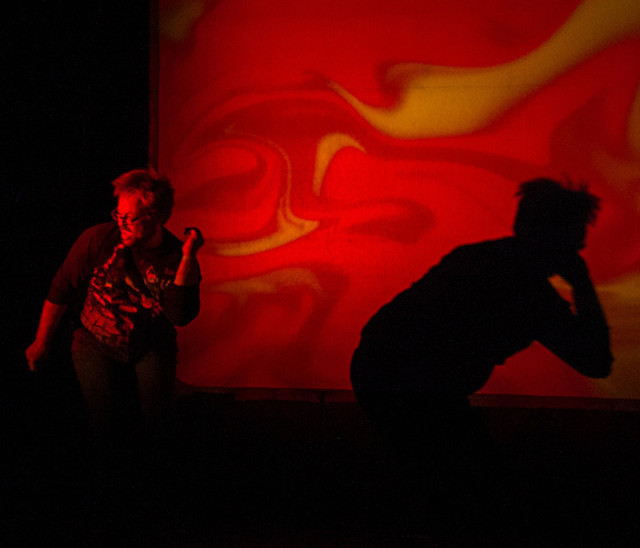
Image: Tomas Valladares
Day 8 - Itai Erdal/Chop Theatre: How to Disappear Completely
The show’s pacing is impeccable. Lighting-designer Erdal balances humor, beauty, and tragedy with the expertise of a tightrope walker. And some of the questions it touches on, such as death with dignity, are poignantly universal while also being courageously personal (to create and then perform night after night a show about your mother's death!). But ultimately, How to Disappear Completely is a profound letter of love to a mother, both wise and humorous, who we all come to cherish—and mourn—by the end.
Day 8 - Campagnie Nacera Belaza: Le Trait solos and Le Temps Scelle
Belaza blends two cultural contexts. Though she left Algeria at five, there’s no mistaking her interest in the rhythms and movements of Morth African music and dance. Most of all, she appears to be interested in the trance rituals. The syncopated rhythms and chanting that pervaded the soundtracks of the evening’s opening “Le Trait solos” mashed up with a single woman’s repetitions of gospel-like vocal motifs are transportive in and of themselves. But the flowering first solo and a second solo in which Nacera simply twirled recalled the kind of ecstatic dances still engaged in both N. Africa and Southern Black Churches. Yet the rigorous form in both was as modern as Merce.
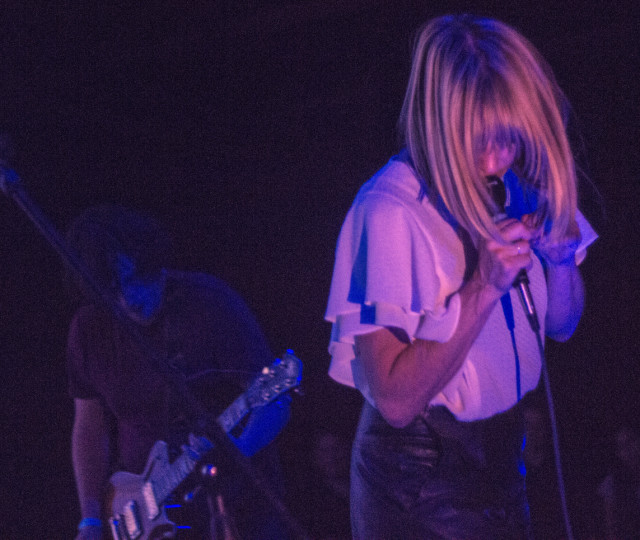
Image: Brian Echon
Day 8 Works - Body/Head
As Body/Head, former Sonic Youth frontwoman Kim Gordon and experimental veteran Bill Nace make largely improvisational noise rock with just two guitars and Gordon’s off-kilter, idiosyncratic vocals. It’s music that demands a lot of concentration and presence of mind, both from the performers and from the audience...At times the set felt languorous, yet when it was over I still felt like it had barely begun. It was evidence that sometimes it’s not a good thing to leave the audience wanting more.
Day 9 - Bouchra Ouizguen: Ha!
Moroccan choreographer Bouchra Ouizguen distills the daily life’s sights and sounds [of the Fez] into a mesmerizing essence...It’s an impressive feat: to bring something so fundamentally “other” to an American stage, yet blast past any sense of voyeurism, not so much through artistry (although there is plenty) as through commitment to a form entirely of their own making.
Day 9 - Mariano Pensotti: Sometimes I Think I Can See You
Do you ever wonder what people think when they see you? The stories they make up inside their heads about your life? The things they don’t make up? What do you imagine about them? In an extreme act of people watching and observation, a group of authors takes turns in the PSU Urban Center Plaza to narrate the lives of passersby...The idea, perhaps, is better than the execution.
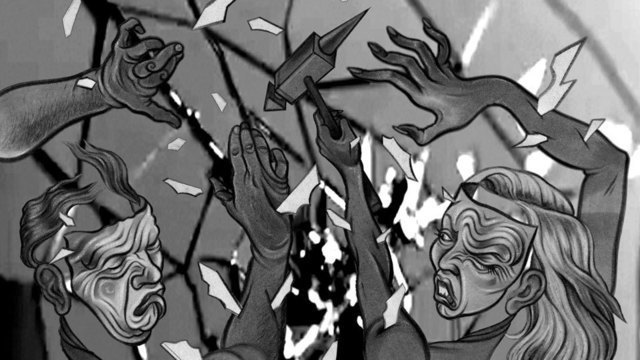
Image: Daniel Barrow
Day 9 - Daniel Barrow: The Thief of Mirrors and Looking for Love in the Hall of Mirrors
Daniel Barrow is a magician. Using nothing but live narration, an overhead projector, a series of slides, and the audience’s own optical illusions, he creates lush, animated fairy tales about a harlequin thief who steals diamonds and tears from the rich, and a literary loving man who can’t find love.
Day 9 - Karen Sherman: One with Other
Minneapolis-based Karen Sherman’s One with Others isn’t quite theater nor quite dance. Instead, it uncomfortably blends elements of each for a result that doesn’t quite take responsibility for its own being. It’s right in the contract that she flashes on screen before the performance starts. “Don’t assume I’m having a deeply somatic experience,” it says, among other declarations relinquishing responsibility for what lies ahead. You sign it, it says below a signature line, by looking. What follows is an occasionally charming but mostly laborious hour of performance—vignettes, really...
Day 9 Works - Alexandro Segade: Boy Band Audition
Unquenchable audience participation, by novices and some of TBA's top performers both, transformed a meager performance into a night for the Works's history books. If I ever have to be in a gang dance off, I want Miguel Gutierrez and Wayne Bund as my captains.
Day 10 - Natasha Kmeto
It’s probably fair to say that most of the people at the Works last night weren’t looking to dance too hard, but Kmeto did an admirable job with a crowd that looked more ready to close out TBA with a mellow nightcap than with one last big party. Her particular hybrid of unrushed, bass-heavy production and ‘90s R&B vocals isn’t going to conjure much movement from resolutely immobile hips, but the grin that spreads across her face when she drops an especially heavy beat could certainly win a few converts from the edges of the dance floor.




